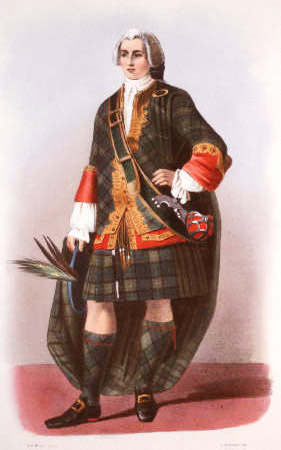Scottish clan chief facts for kids

The Scottish Gaelic word clann means children. Long ago, and maybe even today, members of a Scottish clan believed they all came from the same ancestor. This ancestor was the founder of their clan, and the clan was named after them.
The clan chief (called ceannard cinnidh in Gaelic) is like the main leader or representative of this founder. They represent the whole clan. In the Scottish clan system, a chief is more important than a chieftain (called ceann-cinnidh). A chieftain usually leads a smaller part or branch of a clan.
If a Scottish clan no longer has a recognized clan chief, it is called an armigerous clan. This means they have a coat of arms but no official leader.
Contents
What Clan Chiefs Do
In the past, the main job of a chief was to lead their clan in battles on land and at sea. Chiefs and chieftains in the Scottish Highlands used to be very powerful political figures. They had a lot of authority, and sometimes they used it however they wanted.
However, chiefs no longer have this kind of power today. Being a Highland chief or chieftain now is mostly about social respect and tradition. After the 1745 Jacobite rising, the Highland clans were disarmed. This greatly reduced the power of clans in everyday law. A special law, the Heritable Jurisdictions (Scotland) Act of 1746, took away the traditional legal rights that Scottish clan chiefs once had.
How Chiefs Are Recognized in Scottish Law
Clan Chiefs and Chieftains
Scottish law recognizes that clans, chiefs, and chieftains exist. However, this recognition is mainly about social standing or importance, not about legal power. This recognition comes from the Lord Lyon Court.
According to a former Lord Lyon, Sir Thomas Innes of Learney, a clan is a group known by its special heraldry. It must also be recognized by the King or Queen. Without this royal recognition, a clan chief and the clan itself would not be officially recognized.
The Lord Lyon is an officer of the Crown. When the Lord Lyon grants or recognizes a clan chief's coat of arms, it gives royal recognition to the entire clan. This means clans with recognized chiefs are seen as a "noble community" under Scottish law. A group without a chief recognized by the Lord Lyon has no official standing in Scottish law.
Someone who wants to be recognized as a chief must prove they are the rightful heir to the original coat of arms of the clan's founder. The clan chief is the only person allowed to use the original, unchanged coat of arms of the clan's founder. The clan is seen as the chief's family property, and the chief's coat of arms is like the official seal of the clan.
So, under Scottish law, the chief is recognized as the head of the clan. Once recognized, they are the lawful representative of the clan community all over the world. The Lord Lyon Court is the only authority that can officially record a chief's dignity.
Clan Commander
Sometimes a clan does not have a chief. Or, a family might want to be recognized as a clan. In these cases, clan or family members can hold a special meeting called a derbhfine. A representative from the Lord Lyon must be present.
At this meeting, they can choose a clan chief if there is clear evidence linking them to a chief's family line. If not, they can appoint a clan commander.
The Lord Lyon Court can recognize a clan commander for a temporary time, usually up to ten years. After this time, another derbhfine is needed. It is at this point that a clan chief can be officially recognized by the Lord Lyon Court. Clans with clan commanders are still called armigerous clans.
Special Rights of Clan Chiefs
Supporters on Coats of Arms
Clan chiefs are allowed to have supporters on their coat of arms. These are figures, often animals or people, that stand on either side of the shield. They show that the chief has a very high rank. To be a member of the Standing Council of Scottish Chiefs, a chief must show they have the right to hereditary supporters.
Eagle Feathers
Parts of the chief's coat of arms are often found on the crest badge. Clan members usually wear this badge on a bonnet. These badges usually show the chief's heraldic crest and heraldic motto.
Clan chiefs are allowed to wear three eagle feathers behind their crest badge. Clan chieftains can wear two eagle feathers. Regular clan members do not wear any feathers unless they have been granted their own coat of arms by the Lord Lyon King of Arms. If they have their own arms, they are called an armiger and can wear a crest badge with parts of their own arms.
Sashes
Scottish women wear a sash as part of their national dress. It is usually worn over the right shoulder. However, only the wives of chiefs and chieftains, or women who are chiefs or chieftains themselves, wear it over the left shoulder.
How to Address Them
To learn the correct way to address a Scottish clan chief, you can look at Forms of address in the United Kingdom § Chiefs, chieftains and lairds.
See also

